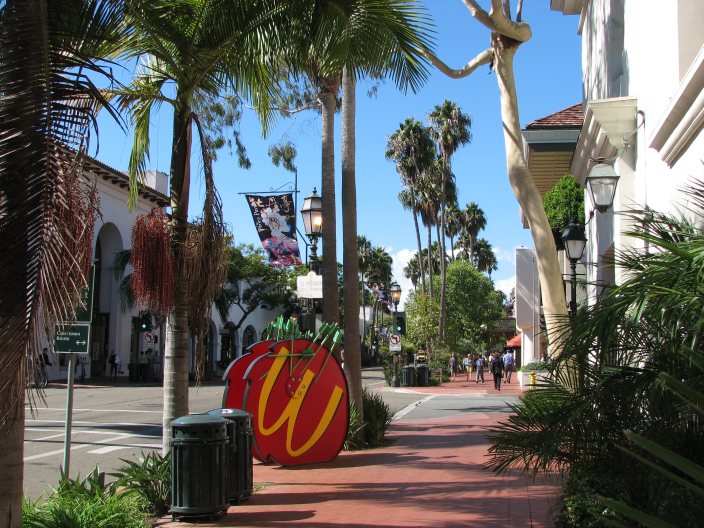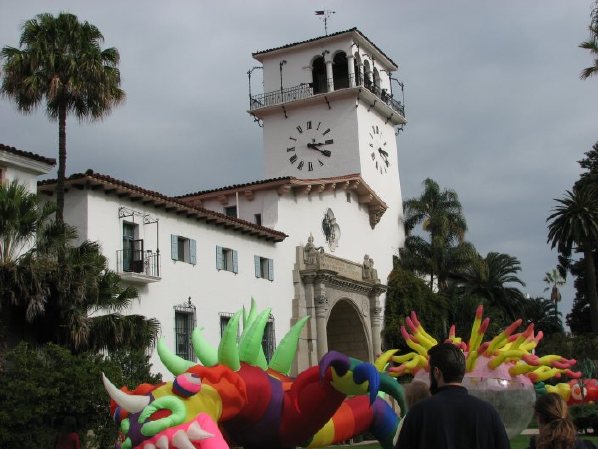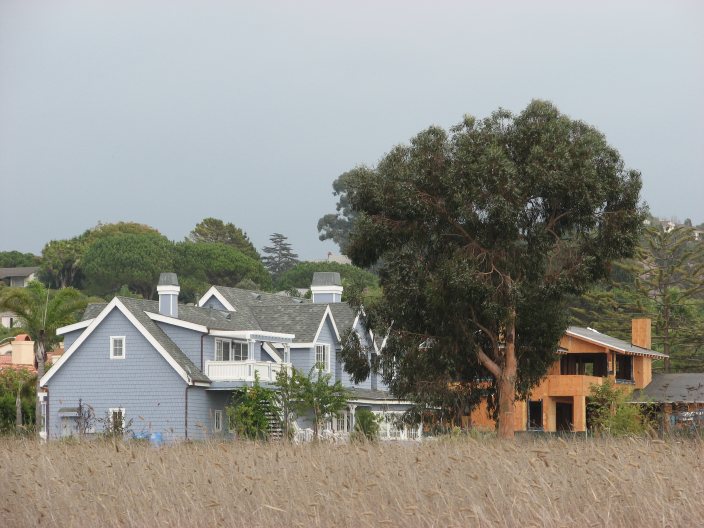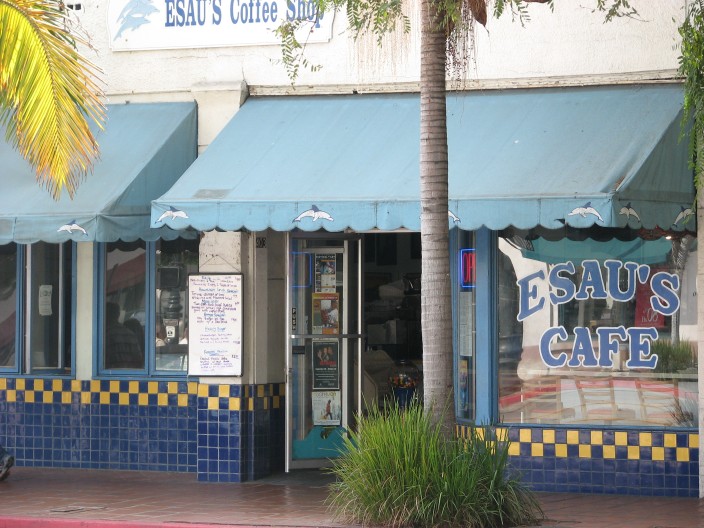

copyright 2006 by George Johnson

Santa Barbara Zoo. photo by George Johnson, copyright 2006
1. Retrofit Arithmetic (and Rainbarrel Economics)
2. The San Juan-Chama Shell Game
3. The Case of the Disappearing Aquifer
4. The Creative Hydrology of Suerte del Sur
5. The City, the County, and a Water Tax Revolt
6. Water Numerology at City Hall
(Our story thus far)
7. The Woman at Otowi Gauge
8. "Forget it, Jake. It's Chinatown."
9. The Las Campanas Connection . . . desalination word games . . . and Aamodt South
(Our story continues)
10. The Engineering Solution
11. The Sorrows of San Acacio
12. The City's Dubious Water Report
13. Where the Water Went
14. Shutting Down the River Again
15. Picking on the Davises
16. The Tom Ford Webcam
17. Galen Buller's Day Off
18. Forgive and Forget
19. Election Postmortem
20. El Molino Gigante
21. Hotel Santa Fe. . . Mansion Watch . . . Water Watch
(Our story continues)
22. The Environmental Impact of Jennifer Jenkins
23. The Short-term Rental Racket . . . Water Watch . . . Mansion Watch . . . Surreal Estate
24. Archbishop Lamy's Parking Lot
25. Mayor Coss's Lost Gamble
26. Tommy Macione Swamp
27. Sweeney Center Blues
28. The Tragedy of the Commoners
29. Councilors, Cops, and Russian Dolls
30. West Side Story
31. Taking Back the River
32. The Case of the Clovis Pigs
33. The San Juan-Chama Shell Game Revisited
October 3, 2006
34. The Santa Barbara Review
Yuma, Arizona bills itself as "the third fastest-growing area in the United States" fueled by cheap housing, mild winters, and an endless supply of Colorado River water only half of which is being consumed. It's a nightmarish thought, this hellhole of strip malls and chain stores doubling in size. On a sweltering evening last week, I found myself sitting outside at what was said to be Yuma's finest restaurant drinking a margarita while water misters cooled the air. Outdoor air conditioning. We were not in Santa Fe anymore.
The next day was even more miserable -- 105 degrees Fahrenheit. Climbing up from El Centro on Interstate 8, I had to turn on the heater -- an extra radiator -- to keep my 1992 Jeep from boiling over. Barrels of radiator water (marked "nonpotable" for the benefit of migrant workers) lined the road. It was a relief finally to arrive in Santa Barbara, California, where for the next two months I will be science writer in residence at the Kavli Institute for Theoretical Physics.
In the interim I will continue to publish, in exile, The Santa Fe Review, comparing how this coastal city -- otherwise so similar to Santa Fe -- deals with the blessings and curses of being one of the world's more attractive places to live.
I will also do my best to keep up with the news back home. Yesterday, when I got the key to my office, I checked my email and learned of a revealing piece in The Reporter by Dan Frosch on this summer's 10 most voracious water users. Topping the list at 117,367 gallons per month, more than most of us use in a year, was local restauranteur Cliff Skogland. His daily total was almost as much as our mayor David Coss used in a month.
For comparison the article also tallied the summer water bills of other local politicians and some journalists. Mine averaged 7,300 gallons a month. Annualized that would be slightly more than a quarter acre-foot a year -- pretty low by most reckonings but, The Reporter says, 43 percent above the average Santa Fe household.
Read Date Gallons Used 6/21/06 13400 7/21/06 4800 8/22/06 3700
Here is my excuse (and I won't plead a water leak). In March we made the strategic error of laying down grama grass and wildflower seeds to restore a patch of meadow that had been wiped out by a sewer excavation project. The plan was to let the seed lie dormant until the summer rains began. Nature did not cooperate. A couple of freak May downpours prematurely germinated the seeds, which had to be kept wet thereafter. The result was, for June, a distressingly high bill that made me wish I had put off planting until the monsoons actually appeared.
"We live in a desert," Dan Ransom, a city water official, told The Reporter. "Water conservation always needs to be on our minds." Sage advice, but Santa Fe is not a desert, which is generally defined as an area receiving an average of less than 10 inches of precipitation a year. Semi-arid Santa Fe (average 13.4 inches) has dipped that low only three times in the last three decades, most recently in 2003.
If you want to see a desert go to Yuma -- 3 inches of rain a year -- where through great feats of politics and engineering there is enough water to spray into the air. Santa Fe, I hope, still has a chance to do better.

October 9, 2006
If gazing across the Rio Grande Valley toward the Jemez range had been valued as highly as a view of the Pacific and Channel Islands, or if Hollywood instead of Albuquerque were directly south, Santa Fe might have exploded into something like what Santa Barbara is today. Climbing up the face of Cerro Gordo a web of curving, interlocked streets and cul de sacs would crest at the summit spilling down the other side into Cerros Colorados and beyond. Shirley Maclaine's would-be mountain along with Tom Ford's, Andrew Davis's, and even Sally Wagner's hills would be similarly ensnared with houses packed on top of houses, fighting for the best view. 
Downtown, just off the Plaza, would be an adobe-styled Macy's and a Saks Fifth Avenue, a Border's and a Barnes and Noble eyeing each other across Palace Avenue or maybe Marcy Street. To caffeinate the shoppers there would be not just one Starbucks but three as well as a number of rival coffee houses. A quaint downtown train station would offer service not just to Albuquerque but north to Española, Taos, Colorado Springs, Denver. Since most people would rather drive, a six-lane highway would run right down Guadalupe Street, bypassing the bypass, and a hundred jets would fly in and out of the airport every day.
Compared with Santa Fe, I've learned in my first week here, Santa Barbara has gotten some things right and a lot of things wrong. I'm sure no one, had they the opportunity to do it over, would have run U.S. 101 a few blocks from the beach and right through the heart of town. And there must be people who wish that something like Santa Fe's escarpment ordinance had been in place and enforced before the hillsides were paved. But it sure is nice having a real downtown where, in addition to the boutiques, galleries, and rubber-stamped Northern Italian sidewalk cafes, there are department stores, drugstores, and movie theaters on State Street, the main drag, and even, incongruously, a Pep Boys. All of this co-exists along with the civic amenities downtown Santa Fe has managed to hang onto: museums, a good public library, and City Hall, all connected by an electric trolley to the beach, the zoo, and other attractions.
Yet for all Santa Barbara's charms, I am already homesick. I miss the Burrito Company and Bumblebee's Baja Grill. For a quick downtown lunch I must settle for a couple of pretty good franchises: Fatburger, a favorite from when I lived briefly down coast in Manhattan Beach, and Chipotle, a Subway-like assembly line for tacos and burritos, where the selection of salsas does not include chipotle, and grated cheese, sour cream, and sliced black olives are offered as components of Mexican food. I miss the Dale Ball Trails, the library at St. John's College, Collected Works bookstore, Radio Free Santa Fe, KSFR, the New Mexican, Journal North, and The Reporter. With a population of more than 400,000 Santa Barbara County, for reasons I will later explore, doesn't have a good newspaper.
Sunday morning, seeking refuge from the red-tiled roofs, I walked across an uncharacteristically empty expanse called More Mesa, named for a rancher, Thomas More, who bought the land in the mid 1800s, to a semi-secret beach I'd read about. Hardly anyone was there. The quiet and isolation were the antidote I'd needed, but the air was too smoggy or soggy for me to see Santa Cruz Island, just 30 miles off the coast. I thought of how from the top of Atalaya I can see Mount Taylor, a hundred miles away, how from my backyard on a dark winter night with a pair of binoculars I can barely make out Andromeda, the galaxy next door, two and a half million light years away.

October 15, 2006
I spent Saturday morning exploring downtown Montecito, as soulless a place as one would ever want to see, setting out on foot along Coast Village Road, a long row of boutiques, restaurants, and real estate offices with all the charm of an Orange County shopping strip. I thought of Gertrude Stein's complaint about another California town: "There's no there there."
Even worse, I soon realized, the buildings on the south side of this anemic Rodeo Drive backed onto Highway 101. Guests spending $275 a night for a room at the Montecito Inn, Charlie Chaplin's old haunt, can gaze across the freeway to the ocean, several blocks away, pretending that the roar is the sound of the surf.
For twice the money they can stay a little closer at The Biltmore, a sprawling Spanish colonial-style resort that I passed on my way to the sand. Picking a path across a slick windrow of boulders placed in front of some condominiums for no apparent reason but to discourage passers-by, I looked down the coast toward Ventura and almost stepped on a seal. I don't know if it was dying or sunning itself on the sand.
It was a relief to return to the reality of Santa Barbara and semi-industrial Milpas Street for tacos adobados at La Tolteca -- so much better than the franchised Chipotle simulation though no rival for El Palenque on Santa Fe's Airport Road.
As I listened to the Mexican music I thought about a late morning meal I had last week at Esau's Coffee Shop, an unpretentious old diner on State Street that is the closest thing I've found to the Plaza Restaurant. Scanning the menu my eye had been caught by, of course, the breakfast burrito. I should have taken it as a warning when the waiter didn't ask "red or green." The item arrived with a scoop of sour cream on top big enough to fill a coffee cup. I dug in with a fork only to find that mixed in with the scrambled eggs were . . . vegetables! Not green chile but bits of zucchini, corn, asparagus, like something left behind in a sink trap. The paper thimble of bland tomato salsa was no help. I sprinkled it all with tabasco, ate a few bites and moved on.

October 15, 2006

City Hall


November 1, 2006
More (and More) Mesa
Neighbors call it the Blue Whale, this behemoth of a house rising on the periphery of the empty wonderland called More Mesa, and its story would be familiar to any Santa Fean. While the other homes crowding the margin of this miraculously deserted 300-acre tract of Santa Barbara coastline squat low to the ground, the builder of the whale was able to get a variance. Last month two members of a local environmental group took me on a tour of the mesa. While we watched White-Tailed Kites hovering over the grassland, swooping down to grab their prey, my guides explained that there was once a two-story farmhouse on the site -- precedent for the county's approval of the Blue Whale. That, of course, opened the barn door and now a second two-story McMansion is rising next door with another 70 houses planned for the northeast corner of the tract.
In a land where a million dollars will buy you a claustrophobic, sheetrock tract house backing onto the traffic of Hollister Avenue (think St. Michael's Drive), this additional development will surely allow the long-time owner, an entity called Sun Mesa Inc., to turn a substantial profit. Of course it wants more. The company is suing to overturn a zoning decision that designates the rest of the mesa as environmentally sensitive habit. Victory for them would mean as many as 300 additional Taco Bell houses, or maybe a luxury resort and golf course, filling the expanse from Atascadero Creek to the ocean.
The coast curves here so that the Pacific lies to the south (disorienting the first few times you see the sun set). On the east side of More Mesa, the old Hope Ranch was turned long ago into Santa Barbara's Beverly Hills, with estates built up to the bluffs. The coastline to the west has also been blocked off by houses.
For the time-being More Mesa remains a beautiful anomaly where one can spend an hour walking along the cliffs, hearing nothing but the waves and an occasional jet overhead.

December 1, 2006
The Return to Santa Fe

Shortly before Thanksgiving, I went by Esau's again, where I had that disappointing breakfast, and was sad to see that it was gone. The sign had been removed and the windows covered with paper, the first steps in the conversion of the old Santa Barbara standby into -- who knows -- another northern Italian restaurant or clothing boutique.
I did finally find a pretty good breakfast burrito (but no green chile) at Altamirano's in funky downtown Goleta, Santa Barbara's poor cousin to the west (where you would still have a hard time finding a house for less than $750,000). I liked Goleta, so different from Montecito on the other side of the bay. A few remaining farms, growing lemons and pumpkins, are surrounded by tract housing. Mexican farm workers bicycle to the fields from wherever they live on the same bike path that carries students to the university.
As I should have suspected, Santa Barbara and vicinity does have a number of excellent Mexican restaurants. My favorites were Del Pueblo, in a suburban strip mall on Hollister Avenue, and Los Arroyos downtown, as good or better than anything in Santa Fe. I was less impressed with Super Rica, reputed to have been Julia Child's favorite taco stand, and I looked in vain for real New Mexican food. At a place on State Street called Zia Cafe (!) I had soggy chiles rellenos with funny little biscuits that were supposed to be sopaipillas served for dessert. On the next block, Left at Albuquerque advertised a menu that included such "Albuquerque Favorites" as tequila-grilled pork chops and "Lefty's Navajo Chicken Stack." It didn't seem worth trying.
I was glad to hit the road for Santa Fe, driving across the Mojave Desert to Las Vegas, where I hadn't been for decades. After checking into New York, New York (the Empire State Building, the Statue of Liberty, the Chrysler Building, a Coney Island roller coaster, and the Brooklyn Bridge squished together to form a hotel casino as big as a city block), I explored the Strip: the Luxor with its pyramid and Sphinx, Caesar's Palace with its Roman Forum and Colosseum. A huge Mongolfier balloon hovered above Paris where the legs of a simulated Eiffel Tower erupted from the casino floor. The grandest of them all, the Bellagio, was outfitted with its own little Lake Como spraying jets of water lit with colored lights. Showing their appreciation thousands of visitors sat at slot machines feeding them with donations of pocket change. Why cross the ocean when the world is right here on Las Vegas Boulevard?
After coffee the next morning in Greenwich Village (New York, New York's food court) I set off for St. George, Utah, where beneath the shadow of a very real tabernacle, a Mormon polygamist was on trial. Detouring north around the Grand Canyon I crossed the Colorado River at the Marble Canyon bridge and cut across the Navajo Reservation to Tuba City. By nightfall I was passing the Hopi mesas listening to ceremonial chants, birthday dedications, and Indian rap on a station broadcasting out of Keams Canyon. Another night in a Gallup motel and finally I was home.

on to Part 35, Kepler's Inquisition . . .
Coming Next: What Happened While I Was Gone
Coming Soon: The Battle for Talaya Hill
The Andrew and Sydney Davis Webcam
Santa Fe Review Detours of the Wild West
The Santa Fe Review

More links:
See the current flow of the Santa Fe River above McClure Reservoir with the USGS automated gauge.
The Otowi gauge shows the flow of the Rio Grande north of Santa Fe.
Santa Fe water information, a collection of documents and links